Ten years after he built the Theatre Royal, John Foulston had his own house built on Townsend Hill, a little to the north of this site. In the 1820s, Mutley Plain was little more than an undeveloped open road. Development took off in the mid 1850s when Messrs Ellery, Fowler and Bennett acquired the two fields known as the Mannameads. Having bought East and West Mannamead, they had the land laid out for a series of villas; in time, the whole area became known as Mannamead.
Illustrations and text about The Mannamead.
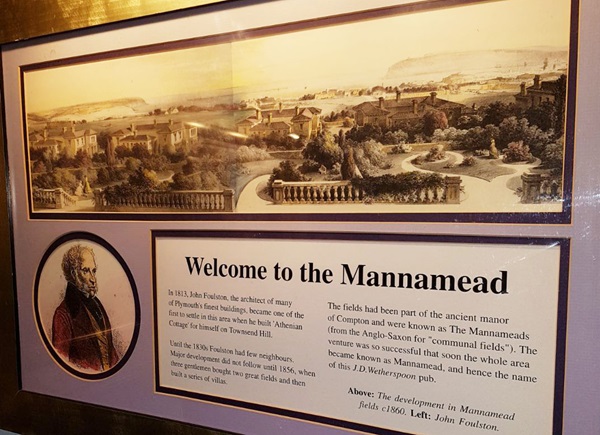
The text reads: In 1813, John Foulston, the architect of many of Plymouth’s finest buildings, became one of the first to settle in this area when he built Athenian Cottage for himself on Townsend Hill.
Until the 1830s Foulston had few neighbours. Major development did not follow until 1856, when three gentlemen bought two great fields and then built a series of villas.
The fields had been part of the ancient Manor of Compton and were known as the Mannameads (from the Anglo-Saxon for ‘communal fields’). The venture was so successful that soon the whole area became known as Mannamead, and hence the name of this J D Wetherspoon pub.
Above: The development in Mannamead fields c1860
Left: John Foulston.
Illustrations and text about the Mannameads.
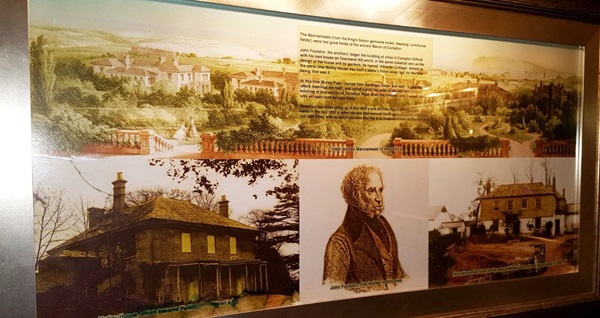
The text reads: The Mannameads (from the Anglo-Saxon ‘gemoene moed’, meaning ‘communal fields’) were two great fields of the ancient Manor of Compton.
John Foulston, the architect, began the building of villas in Compton Glifford with his own house on Townsend Hill which, in the same classical vein as the design of the house and its gardens, he named Athenian Cottage. Almost at the same time Mutley House was built a stone’s throw away; but, for the time being, that was it.
At this time, Mutley Plain – named from the Anglo-Saxon ‘mot-leah’, ‘a clearing where meetings are held’, and called a plain because of the late 18th century levelling of this section of Tavistock Road when the turnpike was created – was only an open road through fields.
Despite a few villas going up in the 1830s and 40s the major development came in the mid 1850s, when the two Mannamead fields were acquired and laid out with villas, with so much success that the area became known as Mannamead.
Illustrations, prints and text about Mutley Plain.
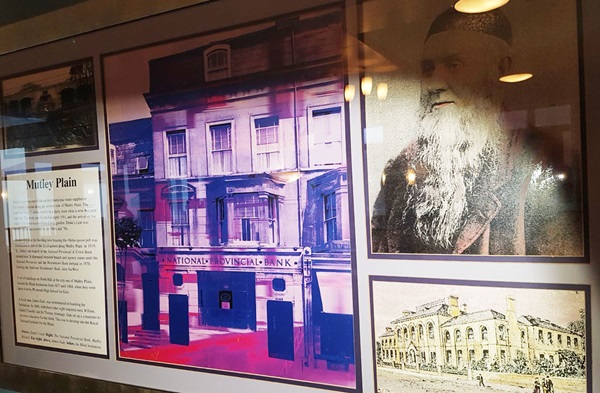
The text reads: Drake’s Leat was one of the earliest municipal water supplies in the country, and ran along the western side of Mutley Plain. The water travelled 17 miles, mostly in a ditch, from what is now Burrator reservoir. The work was finished in April 1591, and the arrival of the water in the town was celebrated with gunfire. Drake’s Leat was largely piped and covered in the 1860s and 70s.
Around that time the building now housing this Wetherspoon pub was constructed as part of the development along Mutley Plain. In 1919, the Mutley sub-branch of the National Provincial & Union Bank opened here. It alternated between branch and agency status until the National Provincial and the Westminster Bank merged in 1970, forming the National Westminster Bank, later NatWest.
A set of buildings on North Hill, at the city end of Mutley Plain, housed the Blind Institution from 1877 until 1964, when they were taken over by Plymouth High School for Girls.
A local man, James Gale, was instrumental in founding the institution. In 1868, with three other sight-impaired men, W Fenn, Daniel Conolly and Dr Thomas Armitage, Gale set up a committee to promote education for the blind. This was to develop into the Royal National Institute for the Blind.
Above: Drake’s Leat
Right: The National Provincial Bank, Mutley Branch
Far right: above, James Gale, below, the Blind Institution.
Prints of Mutley Plain.
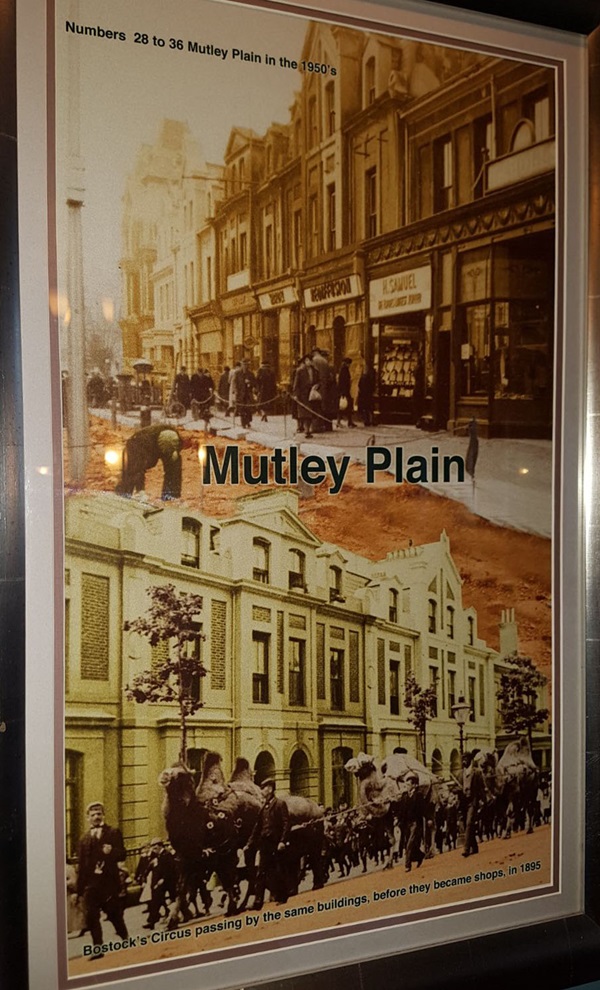
Prints and text about The Blind Institute.
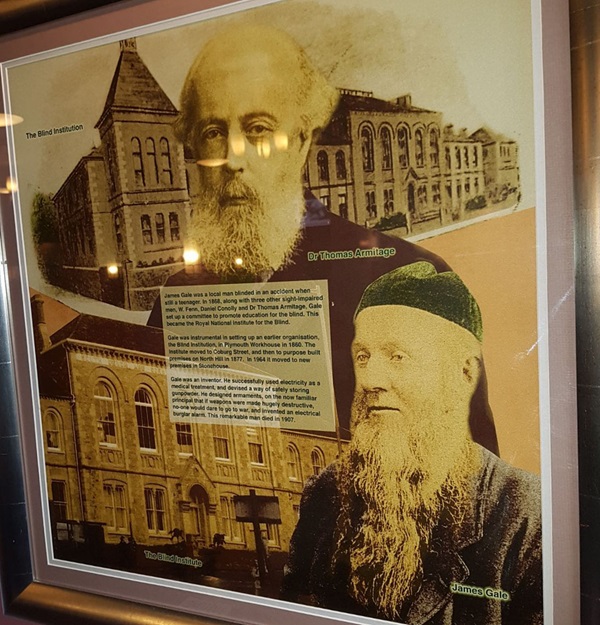
The text reads: James Gale was a local man blinded in an accident when still a teenager. In 1868, along with three other sight-impaired men, W Fenn, Daniel Conolly, and Dr Thomas Armitage, Gale set up a committee to promote education for the blind. This became The Royal National Institute for the Blind.
Gale was instrumental in setting up an earlier organisation, The Blind Institution, in Plymouth Workhouse in 1860. The institute moved to Coburg Street, and then to purpose built premises on North Hill in 1877. In 1964 it moved to new premises in Stonehouse.
Gale was an inventor. He successfully used electricity as a medical treatment, and devised a way of safely storing gunpowder. He designed armaments, on the now familiar principal that if weapons were made hugely destructive, no-one would dare to go to war, and invented an electrical burglar alarm. This remarkable man died in 1907.
Prints, illustrations and text about Drake’s Leat.
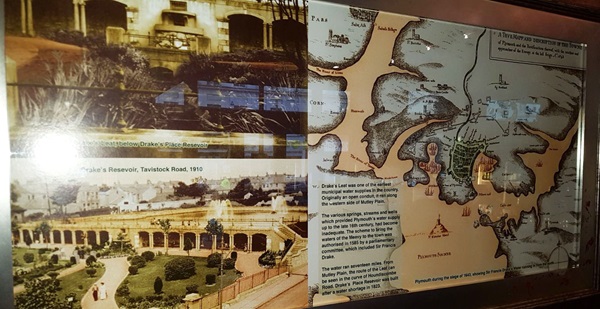
The text reads: Drake’s Leat was one of the earliest municipal water supplies in the country. Originally an open conduit, it ran along the western side of Mutley Plain.
The various springs, streams and wells which provided Plymouth’s water supply up to the late 16th century, had become inadequate. The scheme to bring the waters of the Meavy to the town was authorised in 1585 by a parliamentary committee, which included Sir Francis Drake.
The water ran seventeen miles. From Mutley Plain, the route of the Leat can be seen in the curve of Houndiscombe Road. Drake’s Place Reservoir was built after a water shortage in 1823.
External photograph of the building – main entrance.
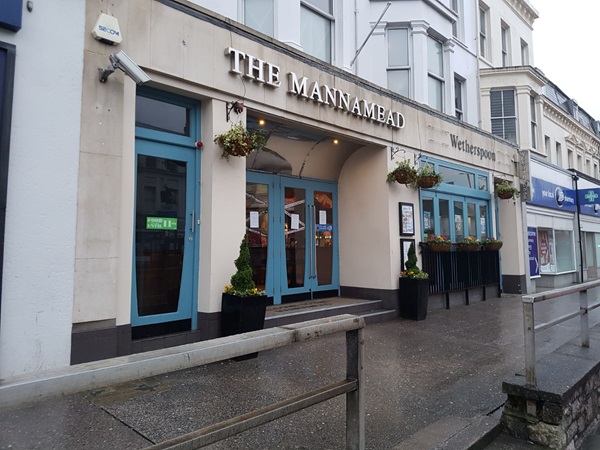
If you have information on the history of this pub, then we’d like you to share it with us. Please e-mail all information to: pubhistories@jdwetherspoon.co.uk